Narcisi Winery
by
Kathy Sullivan
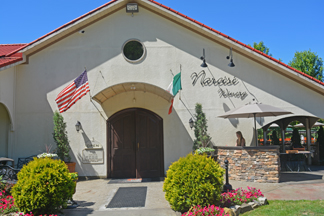 Summary: Narcisi Winery, with an Italia-style architecture, is a popular destination located in western Pennsylvania only a few miles from Pittsbugh. The Italian-style winery has a long history of family winemaking and also features a large restaurant.
Summary: Narcisi Winery, with an Italia-style architecture, is a popular destination located in western Pennsylvania only a few miles from Pittsbugh. The Italian-style winery has a long history of family winemaking and also features a large restaurant.
Narcisi Winery was named for the owners’ last name. The winery and restaurant is enhanced with Italian-style decor. The dedicated tasting room is on the first floor and a small event area is located above the tasting room. The tasting room is filled with wine memorabilia. A short passageway leads to the wine shop filled with a vast assortment of wine-related gift items. Another short passageway leads to La Vite Ristorante. The large wine production area is in another area past the wine shop.
History of Narcisi Winery
The history of the Narcisi winery began in 1911 when Raphael, Giovanni and Gabriele Narcisi immigrated to the United States. Raphael, who was enthusiastic about making wine, continued to make wine for his family and others. Over the years, his son Thomas, learned winemaking skills. This interest in winemaking passed on to Dennis, his nephew, who with his family, opened Narcisi Winery in 2001. Since then Dennis’ son has joined the family operation.
La Vite Ristorante
The La Vite Ristorante opened in 2009 and continues to expand. The atmosphere appeared delightful with seating available inside or outside. The menu includes a wide range of options from appetizers, salads, pizzas and entrees to desserts. If we had the time, we would have liked to have stopped for lunch as the restaurant was enticing.
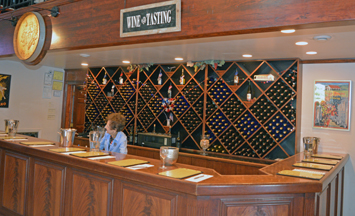 Tasting Room
Tasting Room
The tasting room counter is crafted of fine wood; overhead is an event room where private wine tastings are held. The walls of the tasting room are decorated with an eclectic assortment of wine scenes and decorative items. A large digital display provides information about Narcisi. Nearby we noticed a wine sign, “ I just rescued some wine. It was trapped in a bottle.”
In the tasting room we met Alan, a gentleman who delighted in pouring our wines and telling us about Narcisi. The tasting countertop is covered with copper. Alan noted that the copper is maintained weekly. After tasting a couple of the Narcisi wines, we were invited to attend a private tasting of five wines with Roberto Smiraglio, the general manager and a group of five visitors.
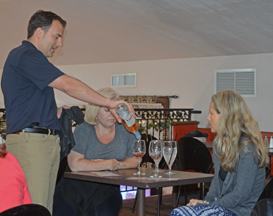 The private wine tasting was extensive with a detailed description of a structured wine tasting. Roberto emphasized that when tasting a wine, one should coat the mouth with the wine. Roberto also discussed what one can learn from the color of a wine including: age (if it is a young or old wine), oxidation and the grape skins. He mentioned how the aroma works with the taste of the wine. After demonstrating the structured tasting, Roberto gave the attendees the opportunity to practice with five of Narcisi’s wines.
The private wine tasting was extensive with a detailed description of a structured wine tasting. Roberto emphasized that when tasting a wine, one should coat the mouth with the wine. Roberto also discussed what one can learn from the color of a wine including: age (if it is a young or old wine), oxidation and the grape skins. He mentioned how the aroma works with the taste of the wine. After demonstrating the structured tasting, Roberto gave the attendees the opportunity to practice with five of Narcisi’s wines.
Currently, Narcisi Winery is producing 15,000 cases of wine. The vast majority of the fruit is sourced from local Pennsylvania wine growers. Roberto noted that Narcisi Winery “is a very dynamic place.” Every year the owners are adding and reinvesting. One of their recent additions was a large cold fermentation room.
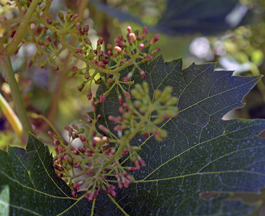 Narcisi only has a small vineyard with Vidal Blanc and Frontenac. The vineyard is located across the road from the winery and restaurant. The grapes from these vines are used for two special Narcisi wines. A demonstration vineyard is located near the parking lot. At the time of our June visit, the grapes clusters were near the flowering stage. Other grapes for the Narcisi wines are sourced from North East, Pennsylvania, an area well known for their vineyards region.
Narcisi only has a small vineyard with Vidal Blanc and Frontenac. The vineyard is located across the road from the winery and restaurant. The grapes from these vines are used for two special Narcisi wines. A demonstration vineyard is located near the parking lot. At the time of our June visit, the grapes clusters were near the flowering stage. Other grapes for the Narcisi wines are sourced from North East, Pennsylvania, an area well known for their vineyards region.
Narcisi Wines
Narcisi wines are available for purchase at the winery and also at some restaurants. Narcisi also has an online option for purchasing wine.
Rosabella 2013 had 11.5% alcohol. This wine is a proprietary blend. The wine was a straw color and offered notes of apple, pear, some yellow stone fruit and citrus. The wine was medium/full-bodied. The finish was crisp. The 2014 Riesling had 12% alcohol. The yellow colored wine offered floral, peach and honeysuckle notes. The wine was slightly sweet but dried on the finish. The finish was crisp and the aftertaste was fruity with floral notes.
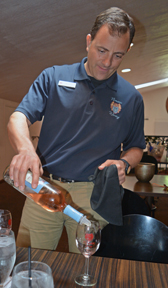 Cabernet Sauvignon 2015 with 13.9% alcohol was a translucent red color. The wine included leather and dark fruit notes including blackberries. The medium/full-bodied wine had bold tannins. Granato 2014 had 11.5% alcohol. This was another proprietary blend of a dry red wine and a blush wine. The Granato name means garnet color which perfectly described the color of the wine. Granato also means pomegranate. The wine was a translucent bright red color. The wine offered cherry and cranberry notes with some sweetness. The finish was very tart. Consider using the Granato as a base for Sangria. Stella 2015 was a blend of Zinfandel and Petite Sirah. The wine with medium tannins offered notes of perfume, figs, prunes and plums. This medium-bodied wine had a crisp finish.
Cabernet Sauvignon 2015 with 13.9% alcohol was a translucent red color. The wine included leather and dark fruit notes including blackberries. The medium/full-bodied wine had bold tannins. Granato 2014 had 11.5% alcohol. This was another proprietary blend of a dry red wine and a blush wine. The Granato name means garnet color which perfectly described the color of the wine. Granato also means pomegranate. The wine was a translucent bright red color. The wine offered cherry and cranberry notes with some sweetness. The finish was very tart. Consider using the Granato as a base for Sangria. Stella 2015 was a blend of Zinfandel and Petite Sirah. The wine with medium tannins offered notes of perfume, figs, prunes and plums. This medium-bodied wine had a crisp finish.
Peach had 11% alcohol. The Peach wine was produced by fermenting peach juice and Vidal Blanc. The result was a wine with an orange color with red hue. The wine aroma and taste was of intense peach notes. The taste was somewhat sweet. The wine was crisp and dried on the finish.
Narcisi Winery is a destination site for visitors looking for wines from Pennsylvania, a friendly atmosphere and an Italian-style restaurant.
Narcisi Winery
4578 Gibsonia Road
Gibsonia, PA 15044
GPS: N40º 36.569’ W79º 53.637’
Article written June 2016
